Tongue color refers to the color of the tongue body. According to Traditional Chinese Medicine (TCM) tongue diagnosis theory, tongue color is generally categorized into pale, light red, red, deep red (crimson), purple, and blue. Essentially, it can be divided into two main groups:
- One group includes pale, light red, red, and crimson, representing different shades of red from light to deep.
- The other group includes purple, light purple, light blue, and blue, indicating a gradual decrease in red pigmentation and an increase in bluish tones.
This classification method serves as the most fundamental and intuitive basis for observation in TCM tongue diagnosis.
Why Can Tongue Color Indicate Disease?
A normal tongue color is typically light red, as the tongue is a muscular organ containing myoglobin in its cytoplasm. Additionally, its connective tissue is rich in capillaries, ensuring an abundant blood supply. As revealed by TCM tongue diagnosis, the blood color is seen through the white, translucent mucous membrane of the tongue, appearing as a light red shade.
When a person falls ill, changes occur in blood composition or concentration, or the tongue mucosal epithelium may thicken, proliferate, or atrophy, leading to alterations in tongue color. Therefore, a healthy individual’s tongue is generally light red, while deviations in color often indicate specific health conditions. This principle forms the foundation of syndrome differentiation and treatment in TCM tongue diagnosis.
Table of Content
一. Pale Tongue
A pale tongue refers to a tongue color that is lighter than normal, appearing pale red with more white and less red, or even completely bloodless. According to Traditional Chinese Medicine (TCM) tongue diagnosis, a pale tongue is often associated with deficiency syndromes and cold syndromes. The severity of the condition can be assessed based on the presence or absence of tongue coating:
- If the tongue has a coating, the condition is relatively mild.
- If the tongue is thin, without coating, and appears withered, the condition is more severe.
1. Pale and Moist Tongue – Cold Constitution
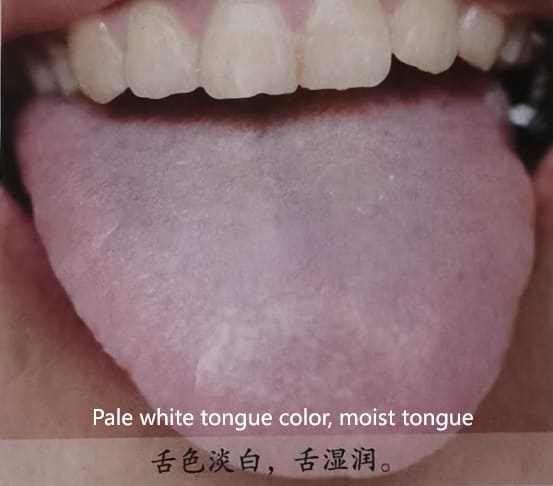
(Image: Pale-colored tongue with a moist surface)
In TCM tongue diagnosis, a pale and moist tongue is commonly seen in internal medicine disorders, while it is less frequently observed in exogenous diseases. Patients with this tongue type should avoid cold and cooling medicinal herbs.
- Tongue characteristics: The tongue appears paler than normal, has a moist surface, and is light-colored.
- Associated conditions: Commonly found in anemia and malnutrition. If excessive body fluids are present, this tongue sign may indicate chronic enteritis, chronic nephritis, or heart failure.
2. Pale Tongue with Less Moisture – Yang Qi Deficiency
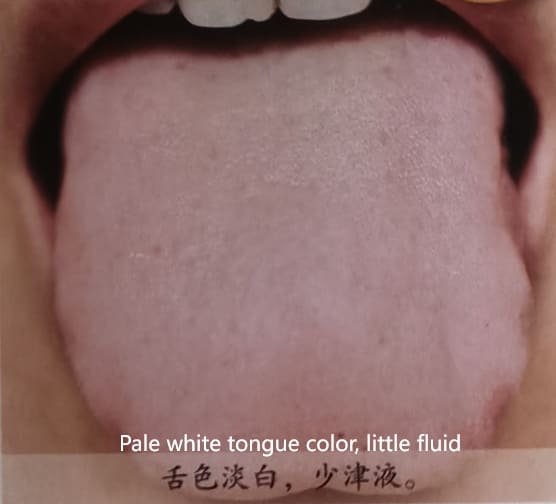
(Image: Pale-colored tongue with insufficient moisture)
This tongue sign is a typical manifestation of yang deficiency. When yang qi is weakened, it fails to generate and distribute body fluids to nourish the tongue. This is an essential observation point in TCM tongue diagnosis.
- Tongue characteristics: The tongue surface lacks adequate moisture or may be completely dry.
- Associated conditions: Common in chronic gastritis, menopausal syndrome, and other diseases related to yang qi deficiency and fluid depletion.
3. Pale and Glossy Tongue – Qi and Blood Deficiency
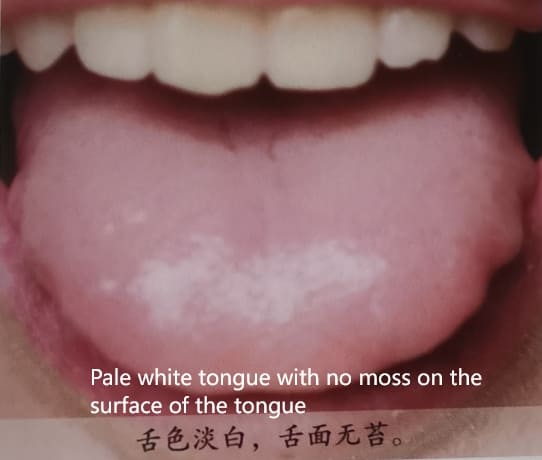
(Image: Pale-colored tongue with a smooth, coating-free surface)
Due to spleen and stomach qi damage, the tongue fails to receive proper nourishment, leading to a complete loss of tongue coating. This condition signifies declining yang qi and qi-blood deficiency, which is a frequent finding in TCM tongue diagnosis.
- Tongue characteristics: The tongue appears pale, smooth, and coating-free.
- Associated conditions: Common in hypothyroidism and chronic kidney disease.
4. Pale Tongue with Stasis Spots – Qi Deficiency with Blood Stasis
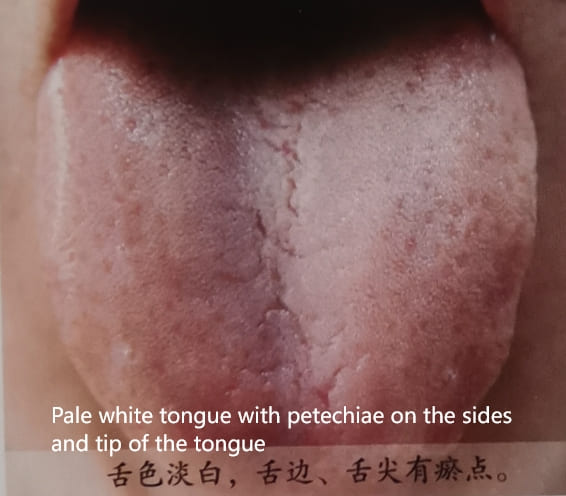
(Image: Pale-colored tongue with stasis spots on the edges or tip)
TCM tongue diagnosis suggests that blood stasis often presents with tongue stasis spots or patches. This condition is typically caused by qi and blood deficiency, leading to poor circulation.
- Tongue characteristics: The edges or tip of the pale tongue may show dark purple spots or patches.
- Associated conditions: Indicates qi deficiency with blood stasis, seen in conditions such as chronic nephritis, chronic heart failure, coronary heart disease, and aplastic anemia.
Regulating a Pale Tongue
Based on TCM tongue diagnosis principles, the main approach to regulating a pale tongue is to tonify qi and blood:
- Sun exposure on the back or moxibustion can help expel cold from the body and enhance yang qi.
- For qi and blood deficiency or yang deficiency, drinking warm black tea can help tonify yang and dispel cold.
- For qi deficiency and blood stasis, consuming yam and red date porridge, with appropriate additions of walnuts, rapeseed, and black beans, can help nourish kidney qi.
二. Red Tongue
A red tongue refers to a tongue that is bright red in color, deeper than the normal tongue shade. In Traditional Chinese Medicine (TCM) tongue diagnosis, a red tongue is often caused by inflammation of the mucosal epithelium and dilation of capillaries, usually indicating internal heat accumulation or insufficient body fluids.
1. Dry Red Tongue with Less Moisture – Indicates Febrile Disease
.jpg)
(Image: Bright red tongue, reduced moisture)
In TCM, a bright red and tender tongue is considered a natural color of the heart meridian. However, when dryness and reduced moisture appear, it suggests that external pathogenic heat has invaded the heart’s nutrient level, causing damage to yin fluids.
- Tongue Features: Bright red, tender tongue; appears glossy but is actually dry and lacking moisture.
- Associated Conditions: Heat entering the interior and damaging body fluids, seen in diseases like pneumonia, meningitis, and other infectious diseases.
2. Tender Red and Moist Tongue – Damp-Heat Combination
.jpg)
(Image: Red tongue with a moist surface)
This tongue appearance indicates a combination of heat and dampness: in febrile diseases, it signifies that the pathogenic heat has penetrated the nutrient level; in chronic internal conditions, it suggests yin deficiency with excessive internal fire and phlegm-damp accumulation.
- Tongue Features: Tender red tongue with a moist surface.
- Associated Conditions: Deficiency fire accompanied by phlegm-damp accumulation.
3. Bright Red Tongue with Cracks – Yin Deficiency with Excessive Internal Fire
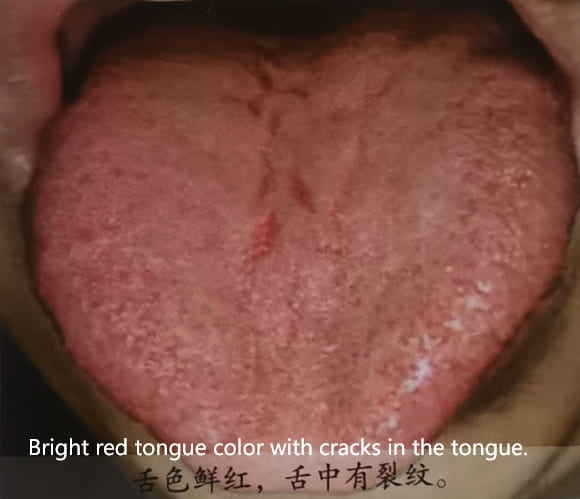
(Image: Bright red tongue with visible cracks in the center)
In TCM, this tongue appearance is seen as a sign of excessive heart fire and heat toxins damaging yin fluids. It indicates that body fluids are insufficient, leading to an inability to nourish and moisten the tongue.
- Tongue Features: Bright red tongue with cracks that resemble “人” (ren), “川” (chuan), “爻” (yao) characters, or irregular fissures; little to no tongue coating.
- Associated Conditions: Yin deficiency with internal heat, pathogenic heat invading the nutrient and blood levels, or stomach yin deficiency. Commonly seen in fever, dehydration, electrolyte imbalance, and diabetes.
4. Bright Red Tongue with Red Spots – Severe Pathogenic Condition

(Image: Red tongue with scattered small red dots)
In TCM tongue diagnosis, the appearance of scattered dark red or purplish-black dots on the tongue surface usually indicates a severe febrile disease, suggesting that the pathogenic heat and toxins have penetrated deeply into the nutrient level.
- Tongue Features: Bright red tongue surface with scattered dark red or purplish-black spots.
- Associated Conditions: Warm febrile diseases, infectious febrile illnesses, which may be accompanied by delirium, excessive thirst, and severe fever. The darker the red or purple-black color, the more severe the condition.
Management of Red Tongue
The treatment principle for a red tongue focuses on nourishing yin and clearing heat:
- Herbal remedies: Herbs such as Polygonatum odoratum (Yuzhu), Lily bulb (Baihe), Ophiopogon (Maidong), and Dendrobium (Shihu) can be used in tea, porridge, or soups.
- Dietary recommendations: Eat light, cooling foods such as bitter melon and watermelon, which help clear heat.
- Acupressure therapy: Stimulating acupoints such as Neiting (ST44), Yuji (LU10), Shaochong (HT9), Laogong (PC8), and Yongquan (KI1) can assist in heat-clearing and balancing the body.
三. Dark Red Tongue
A dark red tongue appears deep red with a hint of purple. This condition signifies extreme heat and is often associated with excess syndromes. It usually develops from a red tongue due to prolonged heat-related illness, leading to severe depletion of bodily fluids. The severity of the condition can be assessed based on the presence or absence of tongue coating and moisture.
1. Dark Red Tongue with Coating – Indicates Warm Disease
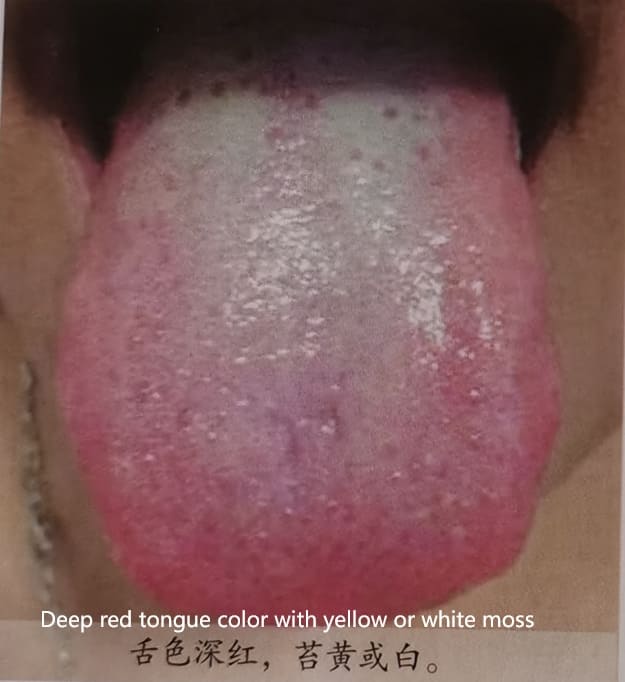
(Image: Dark red tongue with yellow or white coating)
This tongue appearance suggests that pathogenic heat has not entirely invaded the blood system, and the body still retains some Yin fluids.
- Tongue Characteristics: Dark red tongue with a yellow or white coating.
- Associated Conditions: Warm febrile diseases that have reached the nutritive (营) and blood (血) levels, such as bronchitis, pneumonia, viral flu, and heatstroke with high fever.
2. Dark Red, Dry Tongue Without Coating – Yin Fluid Depletion
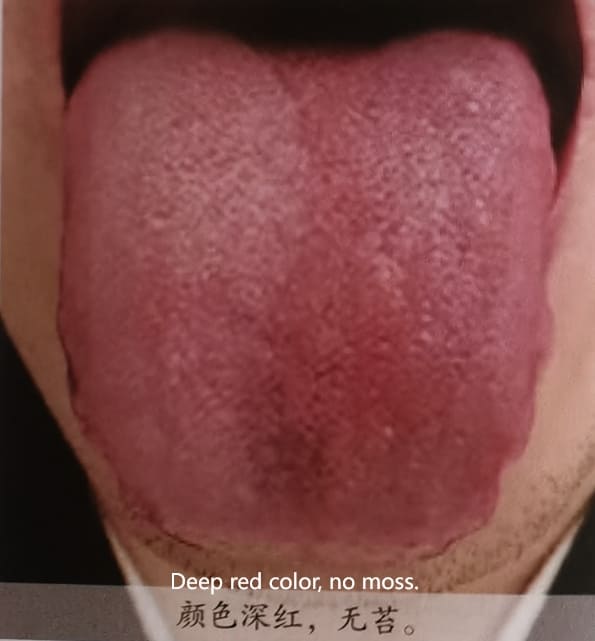
(Image: Deep red tongue, dry, without coating)
This tongue condition indicates a severe pathogenic invasion, excessive heat in the blood, and extreme depletion of body fluids, often associated with poor nutritional status.
- Tongue Characteristics: Dark red tongue, dry and lacking coating.
- Associated Conditions: Yin fluid depletion and damage due to high fever, commonly seen in infectious diseases like pneumonia, meningitis, and bacterial endocarditis.
3. Dark Red Tongue with Yellow Greasy Coating – Pathogen Entering the Nutritive and Blood Levels
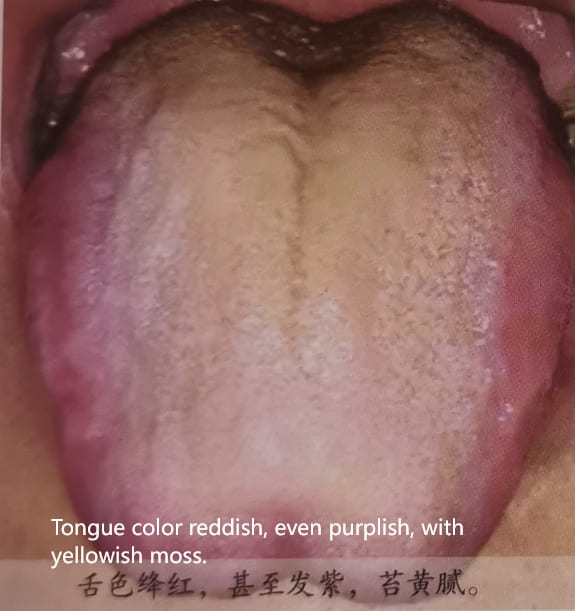
(Image: Deep red tongue with a greasy yellow coating, possibly with swollen veins)
A dark red tongue indicates that heat has invaded the nutritive and blood levels, while the yellow greasy coating suggests the presence of dampness, phlegm, or toxic heat in the body.
- Tongue Characteristics: Dark red tongue with a thick, sticky yellow coating.
- Associated Conditions: Heat invading the blood level, accompanied by damp-heat and phlegm accumulation, often seen in diseases like typhoid fever, meningitis, toxic dysentery, and necrotic appendicitis.
4. Dark Red, Smooth and Shiny Tongue – Pathogen Invading the Heart Pericardium
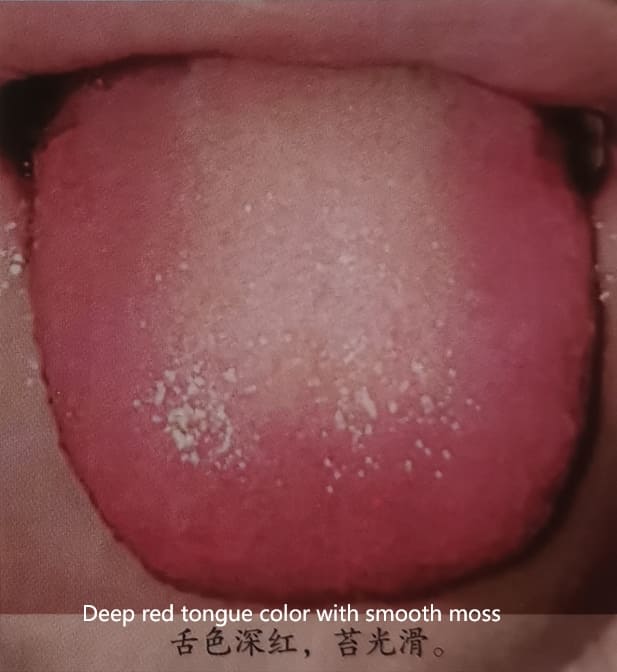
(Image: Deep red tongue, smooth and glossy surface, but not dry)
This tongue condition suggests that not only is the Heart’s nutritive system affected, but the stomach’s fluids have also been severely depleted. It is often seen in severe stages of infectious febrile diseases.
- Tongue Characteristics: Dark red tongue with a mirror-like smooth and shiny surface, yet not dry.
- Associated Conditions: Pathogenic heat invading the pericardium, which can occur in critical conditions such as severe pneumonia or meningitis.
Management and Remedies for a Dark Red Tongue
The primary principle for treating a dark red tongue is to nourish kidney Yin and clear excessive heat.
- Ligustrum lucidum (女贞子) is excellent for nourishing kidney Yin and can be used in soups, porridge, or tea.
- For heat caused by Yin deficiency, consume black foods like black rice, black beans, black dates, and black sesame.
- Vitamin C helps boost immune function; eat more vitamin C-rich fruits and vegetables.
- For Yin deficiency with excess internal heat, massage the Rangu (然谷) acupoint to balance Yin and Yang.
四. Purple Tongue
A purple tongue is characterized by a deep reddish-blue hue and a dark, dull appearance. In Traditional Chinese Medicine (TCM) tongue diagnosis, a purple tongue generally indicates stagnation of venous blood flow, leading to local hypoxia. Purple tongue can be associated with cold syndromes, heat syndromes, or blood stasis syndromes. Additionally, based on different shades of purple, it can be classified into different types:
- Bluish-purple tongue (青紫舌) suggests internal cold syndromes.
- Reddish-purple tongue (绛紫舌) indicates high fever damaging body fluids.
- Dark purple tongue (暗紫舌) signifies blood stagnation.
- Swollen purple tongue (紫舌胖大) suggests internal accumulation of alcohol toxins.
1. Bluish-Purple Tongue – Internal Cold Syndromes
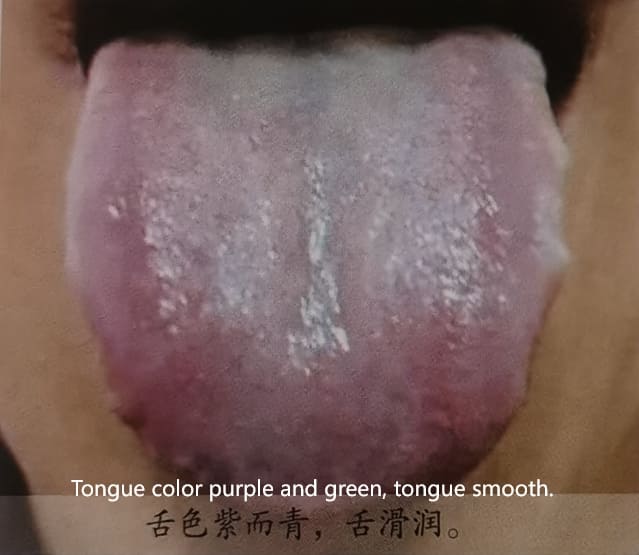
(Image: Purple tongue with a bluish hue, moist and smooth surface)
When the internal organs suffer from cold deficiency, Qi and blood circulation slow down, leading to a bluish-purple tongue. If the bluish-purple tongue develops from a pale tongue and is accompanied by a moist surface, cold limbs, and bluish lips, it indicates a deficiency of Yang and an excess of internal cold.
- Tongue Characteristics: Purple tongue with a bluish tint, smooth and moist surface.
- Associated Conditions: Internal cold syndrome, cold stagnation leading to blood stasis, seen in conditions such as coronary heart disease, heart failure, chronic nephritis, and asthma.
- Related Symptoms: Weak constitution, more common in elderly individuals.
2. Reddish-Purple Tongue – High Fever Damaging Body Fluids
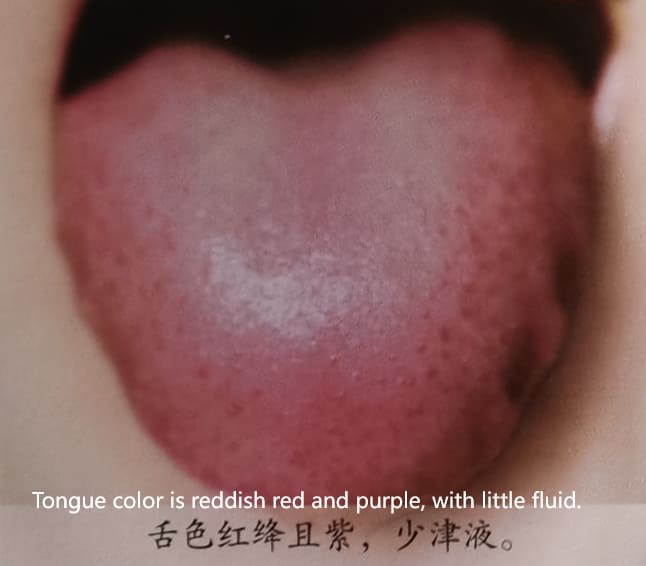
(Image: Deep red-purple tongue, dry with little moisture)
A reddish-purple tongue in TCM often indicates extreme heat invading the blood system, leading to Qi and blood stagnation. This tongue type is typically seen in febrile diseases at the stage of high fever with fluid depletion.
- Tongue Characteristics: Deep red-purple color, usually dry with reduced moisture.
- Associated Conditions: High fever consuming fluids, Qi and blood stagnation, seen in infectious fevers, dehydration, and viral infections.
- Related Symptoms: The deeper and darker the purple hue, the more severe the condition.
3. Dark Purple Tongue – Blood Stagnation
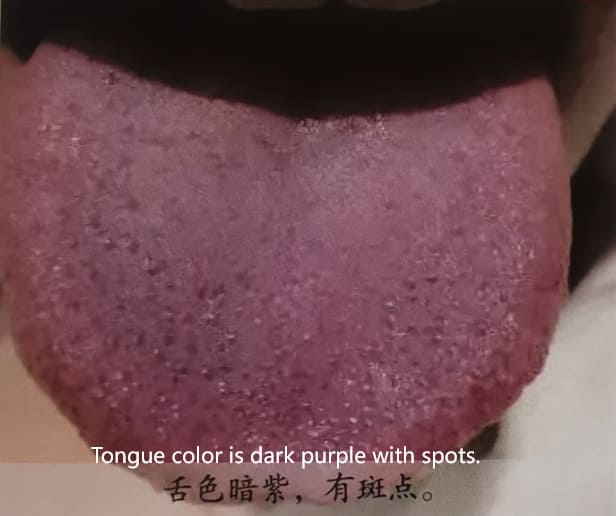
(Image: Dark purple tongue with stasis spots)
A dark purple tongue indicates poor blood circulation, which may be due to excessive heat, blood thickening, or fluid depletion. In TCM, this type of tongue is often accompanied by stasis spots or petechiae.
- Tongue Characteristics: Dark purple, dull surface, often with stasis spots or petechiae.
- Associated Conditions: Blood heat leading to stagnation, damp-heat with stasis, seen in severe infections, cardiovascular diseases, and cerebrovascular conditions.
4. Swollen Purple Tongue – Alcohol Toxin Accumulation
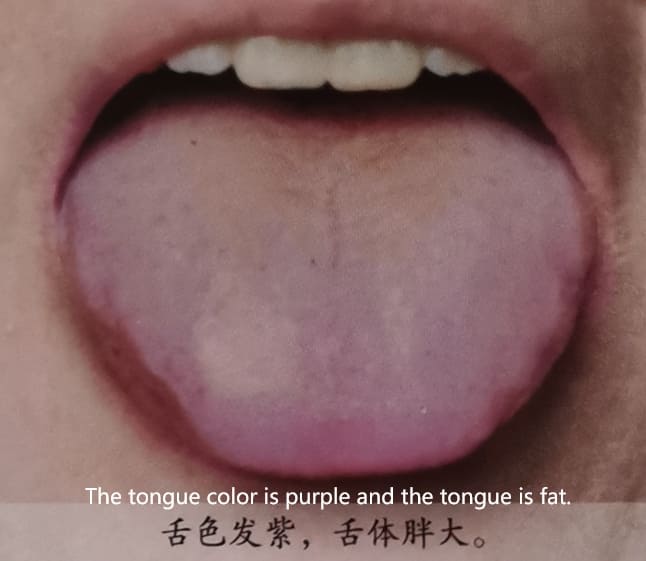
(Image: Purplish swollen tongue with dryness)
A swollen purple tongue often results from excessive alcohol consumption or overeating, leading to dampness, heat accumulation, and damage to the spleen and stomach.
- Tongue Characteristics: Swollen tongue with a purple hue, dry and lacking moisture.
- Associated Conditions: Accumulation of alcohol toxins, often accompanied by bitter taste in the mouth, nausea, and bloating.
Regulation and Treatment for Purple Tongue
Treatment for purple tongue should focus on dispelling cold and dampness, invigorating Qi and blood circulation, and strengthening the spleen and stomach:
- Scraping therapy (Gua Sha) on the back can help remove cold and promote blood circulation.
- Lamb soup with ginger and black pepper can help expel cold and strengthen Yang energy.
- Foods that promote Qi and blood circulation, such as rose tea and hawthorn, should be consumed.
- Acupressure on the ‘Hand Sanli’ point (LI-10) helps regulate digestive function, particularly beneficial for those with cold-induced digestive issues.
五. Cyanotic Tongue
A cyanotic tongue appears bluish, resembling visible veins beneath the skin, and lacks any redness. In traditional Chinese medicine (TCM), a cyanotic tongue is primarily caused by cold stagnation or blood stasis, which obstructs yang energy flow. Modern medicine associates it with microcirculation disorders, making it an indicator of microcirculatory health.
1. Bluish Tongue Edges – Liver Qi Stagnation & Blood Stasis
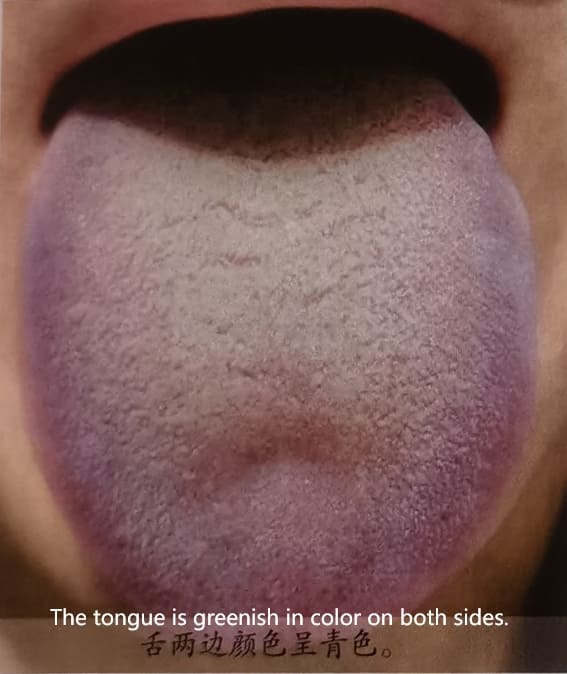
(Image: The edges of the tongue appear blue.)
According to TCM tongue diagnosis, the sides of the tongue correspond to the liver meridian. Bluish edges often indicate cold stagnation or blood stasis in the liver meridian, commonly found in individuals with liver qi stagnation and blood stasis.
- Tongue Characteristics: The edges of the tongue appear bluish.
- Associated Conditions: Liver meridian blood stasis, yang energy obstruction, and cold stagnation, often seen in pain-related disorders.
- Related Symptoms: Emotional fluctuations, discomfort in the hypochondrium (area under the ribs), and chest tightness.
2. Cyanotic & Moist Tongue – Cold Stagnation
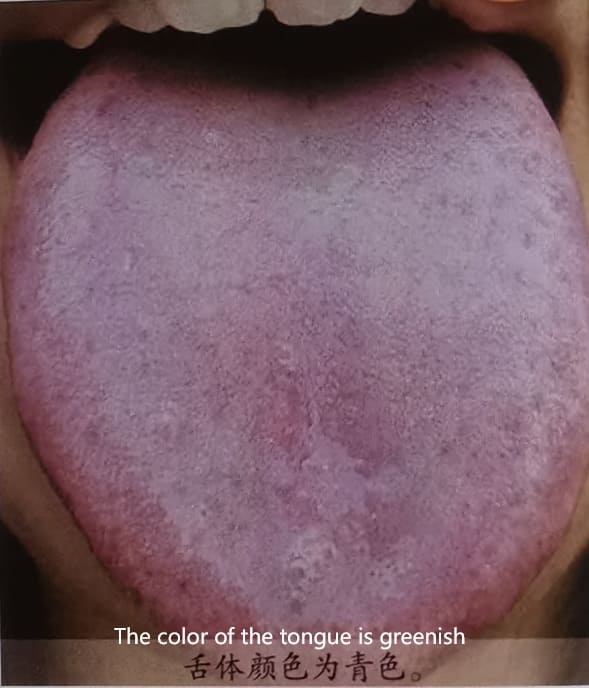
(Image: Tongue body appears cyanotic.)
A cyanotic and moist tongue suggests that cold stagnation has penetrated the internal organs, leading to qi and blood stagnation.
- Tongue Characteristics: The tongue appears blue and is smooth and moist.
- Associated Conditions: Organ deficiency and cold invasion, liver meridian cold stagnation, seen in conditions such as chronic enteritis.
- Related Symptoms: Chills, abdominal pain, and sensitivity to cold.
3. Cyanotic & Dry Tongue – Internal Blood Stasis
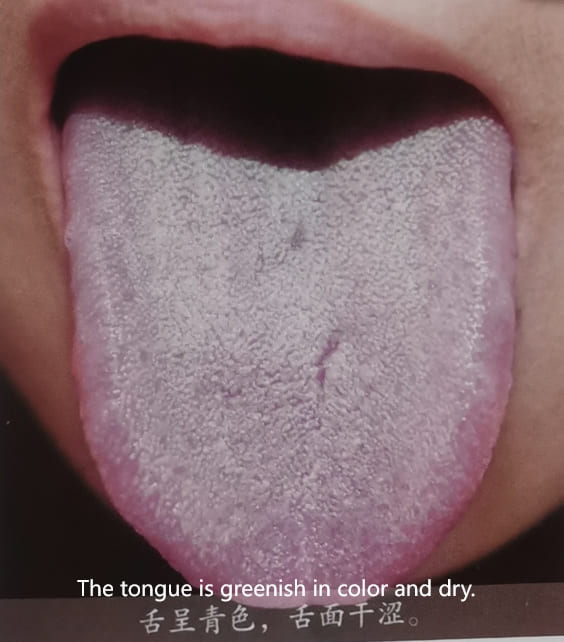
(Image: The tongue appears blue and dry.)
In TCM, a dry cyanotic tongue indicates that cold has invaded the organs, causing blood to stagnate, as “cold congeals blood.”
- Tongue Characteristics: The tongue appears blue with a slightly dry surface, sometimes accompanied by a grayish coating.
- Associated Conditions: Yang deficiency with cold congealing, internal blood stasis, found in external pathogenic conditions as well as chronic diseases.
- Related Symptoms: Poor circulation, persistent cold limbs, and possible dizziness.
4. Cyanotic Tongue with Red Dots – Dampness-Induced Blood Stasis

(Image: The tongue appears pale blue with red dots along the edges.)
In TCM, a cyanotic tongue with red dots signals internal blood stasis, often linked to dampness blocking circulation.
- Tongue Characteristics: The tongue appears pale blue with red dots on the edges.
- Associated Conditions: Blood deficiency combined with dampness-induced blood stasis.
- Related Symptoms: Fatigue, heavy limbs, and sluggish digestion.
Regulation & Treatment for Cyanotic Tongue
To improve a cyanotic tongue, the primary focus should be on warming yang energy, dispersing cold, and promoting blood circulation:
- Herbal Therapy: Formulas such as Si Ni Tang (Four-Reversal Decoction) and Fu Zi Li Zhong Tang (Aconite & Ginger Decoction) can help warm the body and dispel cold stagnation.
- Acupressure & Moxibustion: Massaging or applying moxibustion to Hegu (LI-4) can help improve circulation and regulate qi and blood flow.
- Dietary Adjustments: Avoid consuming cold and raw foods such as ice cream and chilled beverages. Instead, opt for warm, easily digestible foods.
- Lifestyle Modifications: Engage in light exercise such as walking and self-massage to aid circulation and body warmth.
Summary
In Chinese Tongue Diagnosis, the color and appearance of the tongue are vital tools for understanding a person’s overall health. By examining Tongue Color, TCM practitioners can assess underlying imbalances such as heat, cold, blood stasis, or deficiency, and provide targeted treatment. The variations in tongue color—from pale to red, dark red, purple, and cyanotic—offer invaluable insights into the body’s condition. Whether it’s addressing a pale tongue associated with deficiency or managing internal heat with a red or dark red tongue, Chinese Tongue Diagnosis serves as a critical aspect of traditional healing practices. With this diagnostic method, individuals can achieve better health by addressing the root causes of their symptoms based on tongue color changes.
———————————————————————————————————————————————————————————————————–
More Articles in “Identification Tongue”:
- Tongue Sensation & Taste
- Tongue Shape
- Tongue Color
- Tongue Condition
- Tongue Coating
Subscribe now and enjoy 15% off your first purchase
.png)







